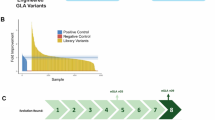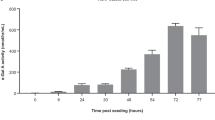Abstract
Fabry disease is a disorder of glycosphingolipid metabolism caused by deficiency of lysosomal α–galactosidase A (α–Gal A), resulting in renal failure along with premature myocardial infarction and strokes1,2. No effective treatment of this disorder is available at present. Studies of residual activities of mutant enzymes in many Fabry patients showed that some of them had kinetic properties similar to those for normal α–Gal A, but were significantly less stable, especially in conditions of neutral pH (refs. 3,4,5 ). The biosynthetic processing was delayed in cultured fibroblasts of a Fabry patient6, and the mutant protein formed an aggregate in endoplasmic reticulum7, indicating that the enzyme deficiency in some mutants was mainly caused by abortive exit from the endoplasmic reticulum, leading to excessive degradation of the enzyme. We report here that 1–deoxy–galactonojirimycin (DGJ), a potent competitive inhibitor of α–Gal A, effectively enhanced α–Gal A activity in Fabry lymphoblasts, when administrated at concentrations lower than that usually required for intracellular inhibition of the enzyme. DGJ seemed to accelerate transport and maturation of the mutant enzyme. Oral administration of DGJ to transgenic mice overexpressing a mutant α–Gal A substantially elevated the enzyme activity in some organs. We propose a new molecular therapeutic strategy for genetic metabolic diseases of administering competitive inhibitors as 'chemical chaperons' at sub–inhibitory intracellular concentrations.
This is a preview of subscription content, access via your institution
Access options
Subscribe to this journal
Receive 12 print issues and online access
$209.00 per year
only $17.42 per issue
Buy this article
- Purchase on Springer Link
- Instant access to full article PDF
Prices may be subject to local taxes which are calculated during checkout




Similar content being viewed by others
References
Brady, R.O. et al. Enzymatic defect in Fabry's disease. N. Engl. J. Med. 276, 1163–1167 ( 1967).
Desnick, R.J., Ioannou, Y.A. & Eng, C.M. in The Metabolic and Molecular Bases of Inherited Disease (eds. Scriver, C.R., Beaudet, A.L., Sly, W.S. & Valle, D.) 2741–2784 (McGraw–Hill, New York, 1995).
Romeo, G. et al. Residual activity of α–galactosidase A in Fabry's disease. Biochem. Genet. 13, 615– 628 (1975).
Bishop, D.F., Grabowski, G.A. & Desnick, R.J. Fabry disease: An asymptomatic hemizygote with significant residual α–galactosidase A activity. Am. J. Hum. Genet. 33, 71A (1981).
Ishii, S., Kase, R., Sakuraba, H. & Suzuki, Y. Characterization of a mutant α–galactosidase gene product for the late–onset cardiac form of Fabry disease. Biochem. Biophys. Res. Comm. 197, 1585–1589 (1993).
Lemansky, P. et al. Synthesis and processing of α–galactosidase A in human fibroblasts. J. Biol. Chem. 262, 2062–2065 (1987).
Ishii, S. et al. Aggregation of the inactive form of human α–galactosidase in the endoplasmic reticulum. Biochem. Biophys. Res. Comm. 220, 812–815 (1996).
Sakuraba, H. et al. Identification of point mutations in the α–galactosidase A gene in classical and atypical hemizygotes with Fabry disease. Am. J. Hum. Genet. 47, 784–789 (1990).
Ishii, S., Sakuraba, H. & Suzuki, Y. Point mutations in the upstream region of the α–galactosidase A gene exon 6 in an atypical variant of Fabry disease. Hum. Genet. 89, 29–32 ( 1992).
Ishii, S. et al. α–Galactosidase transgenic mouse: Heterogenous gene expression and posttranslational glycosylation in tissues. Glycoconj. J. 15, 591–594 ( 1998).
Gilliland, G., Perrin, S., Blanchard, K. & Bunn, H.F. Analysis of cytokine mRNA and DNA: Detection and quantitation by competitive polymerase chain reaction. Proc. Natl. Acad. Sci. USA 87, 2725–2729 (1990).
Fleischer, S. & Kervina, M. Subcellular fractionation of rat liver. Methods Enzymol. 31, 6– 41 (1974).
Hurtley, S.M. & Helenius, A. Protein oligomerization in the endoplasmic reticulum. Annu. Rev. Cell Biol. 5, 277–307 (1989).
Dale, M. P. et al. Reversible inhibitors of β–glucosidase. Biochemistry 24, 3530–3539 (1985).
Asano, N., Oseki, K., Kizu, H. & Matsui, K. Nitrogen–in–the–ring pyranoses and furanoses: Structural basis of inhibition of mammalian glycosidases. J. Med. Chem. 37, 3701– 3706 (1994).
Asano, N. et al. Homonojirimycin isomers and glycosides from Aglaonema treubii . J. Nat. Prod. 60, 98– 101 (1997).
Block, T.M. et al. Treatment of chronic hepadnavirus infection in a woodchuck animal model with an inhibitor of protein folding and trafficking. Nature Med. 4, 610–614 ( 1998).
Goss, P.E. et al. A phase I study of swainsonine in patients with advanced malignancies. Cancer Res. 54, 1450–1457 (1994).
Abe, A., Radin, N. S. & Shayman, J.A. Induction of glucosylceramide synthase by synthase inhibitors and ceramide. Biochim. Biophys. Acta 1299 , 333–341 (1996).
Neuenhofer, S., Schwarzmann, G., Egge, H. & Sandhoff, K. Synthesis of lysogangliosides, Biochemistry 24, 525–532 (1985).
Mitsutake, S., Kita, K., Okino, N. & Ito, M. [14C]–Ceramide synthesis by sphingolipid ceramide N–deacylase: New assay for ceramidase activity detection. Anal. Biochem. 247, 52–57 (1997).
Oshima, A. et al. Intracellular processing and maturation of mutant gene products in hereditary β–galactosidase deficiency (β–galactosidosis). Hum. Genet. 93, 109–114 (1994).
Acknowledgements
We thank Y. Kushi and S. Handa (Tokyo Medical and Dental University) for providing CTH; M. Ito (Kyushu University) for providing sphingolipid ceramide N–deacylase; K. Mannen (Oita Medical University) for animal care; A. Oshima (National Institute of Infectious Diseases, Japan), N. Ishida, H. Kubo, and Y. Hashimoto (The Tokyo Metropolitan Institute of Medical Science) for technical advice; R.O. Brady (NIH) for discussions; Y.C. Lee (The Johns Hopkins University) for critical reading and advice on preparing the manuscript as well as suggestions; and A. Suzuki (The Tokyo Metropolitan Institute of Medical Science) for discussions. This work was supported in part by grants from the Ministry of Education, Science, Sports and Culture and the Ministry of Health and Welfare of Japan.
Author information
Authors and Affiliations
Corresponding author
Rights and permissions
About this article
Cite this article
Fan, JQ., Ishii, S., Asano, N. et al. Accelerated transport and maturation of lysosomal α–galactosidase A in Fabry lymphoblasts by an enzyme inhibitor. Nat Med 5, 112–115 (1999). https://doi.org/10.1038/4801
Received:
Accepted:
Issue Date:
DOI: https://doi.org/10.1038/4801
This article is cited by
-
A short and efficient formal synthesis of (R)-pipecolic acid from the ring expansion of chiral aziridine
Monatshefte für Chemie - Chemical Monthly (2024)
-
Pharmacological targeting of endoplasmic reticulum stress in disease
Nature Reviews Drug Discovery (2022)
-
Quantifying lysosomal glycosidase activity within cells using bis-acetal substrates
Nature Chemical Biology (2022)
-
Fabry Disease: The Current Treatment Landscape
Drugs (2021)
-
A case of latent heterozygous Fabry disease in a female living kidney donor candidate
CEN Case Reports (2021)



